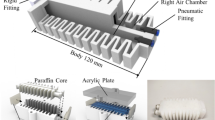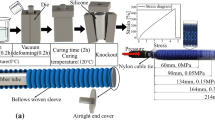Abstract
Several soft robots consist of pneumatic actuators which are developed by using rubber-like materials such as silicone rubber, dragon skin, elastosil, and ecoflex. The complex geometry and nonlinearity in the soft pneumatic actuator (SPA) make the analytical model very difficult to predict the bending behavior of the SPA. The computational simulation technique also known as the finite element method (FEM) is an alternative and effective way to determine the bending behavior of soft actuators. In this work, two SPAs with the plane and corrugated structures are designed and compared in terms of bending angle using FEM. Ecoflex 0050 hyperelastic material model is considered for the analysis. From the FEM simulation results, it has been observed that the SPA with corrugated structure is more efficient because it shows a higher bending angle even at low pressure as compared to the plane-structured SPA. Moreover, a finer mesh led to the accurate distribution of stress and bending angle of the SPA.
Access this chapter
Tax calculation will be finalised at checkout
Purchases are for personal use only
Similar content being viewed by others
References
Bao G, Fang H, Chen L, Wan Y, Xu F, Yang Q, Zhang L (2018) Soft robotics: academic insights and perspectives through bibliometric analysis. Soft Rob 5(3):229–241
Kovač M (2014) The bioinspiration design paradigm: a perspective for soft robotics. Soft Rob 1(1):28–37
Whitesides GM (2018) Soft robotics. Angew Chem Int Ed 57(16):4258–4273
George Thuruthel T, Ansari Y, Falotico E, Laschi C (2018) Control strategies for soft robotic manipulators: a survey. Soft Rob 5(2):149–163
Coyle S, Majidi C, LeDuc P, Hsia KJ (2018) Bio-inspired soft robotics: material selection, actuation, and design. Extreme Mech Lett 22:51–59
Wang J, Fei Y, Pang W (2019) Design, modeling, and testing of a soft pneumatic glove with segmented PneuNets bending actuators. IEEE/ASME Trans Mechatron 24(3):990–1001
Fei Y, Wang J, Pang W (2019) A novel fabric-based versatile and stiffness-tunable soft gripper integrating soft pneumatic actuators and wrist. Soft Rob 6(1):1–20
Ellis DR, Venter MP, Venter G (2021) Soft pneumatic actuator with bimodal bending response using a single pressure source. Soft Rob 8(4):478–484
Kim Y, Cha Y (2020) Soft pneumatic gripper with a tendon-driven soft origami pump. Front Bioeng Biotechnol 8:461
Hu W, Alici G (2020) Bioinspired three-dimensional-printed helical soft pneumatic actuators and their characterization. Soft Rob 7(3):267–282
Zolfagharian A, Mahmud MP, Gharaie S, Bodaghi M, Kouzani AZ, Kaynak A (2020) 3D/4D-printed bending-type soft pneumatic actuators: fabrication, modelling, and control. Virtual Phys Prototyping 15(4):373–402
Gariya N, Kumar P (2021) A review on soft materials utilized for the manufacturing of soft robots. Mater Today: Proc 46:11177–11181
Zhong G, Hou Y, Dou W (2019) A soft pneumatic dexterous gripper with convertible grasping modes. Int J Mech Sci 153:445–456
Dharbaneshwer SJ, Thondiyath A, Subramanian SJ, Chen IM (2021) Finite element-based grasp analysis using contact pressure maps of a robotic gripper. J Braz Soc Mech Sci Eng 43(4):1–11
Zhang H, Kumar AS, Fuh JYH, Wang MY (2018) Design and development of a topology-optimized three-dimensional printed soft gripper. Soft Rob 5(5):650–661
Xiao W, Hu D, Chen W, Yang G, Han X (2021) A new type of soft pneumatic torsional actuator with helical chambers for flexible machines. J Mech Robot 13(1):011003
Barbosa IM, Alves PR, Silveira ZC (2021) Upper limbs’ assistive devices for stroke rehabilitation: a systematic review on design engineering solutions. J Braz Soc Mech Sci Eng 43(5):1–16
Takayama T, Sumi Y (2021) Self-excited air flow passage changing device for periodic pressurization of soft robot. ROBOMECH J 8(1):1–12
Shintake J, Cacucciolo V, Floreano D, Shea H (2018) Soft robotic grippers. Adv Mater 30(29):1707035
Hughes J, Culha U, Giardina F, Guenther F, Rosendo A, Iida F (2016) Soft manipulators and grippers: a review. Front Robot AI 3:69
Shintake J, Rosset S, Schubert B, Floreano D, Shea H (2016) Versatile soft grippers with intrinsic electroadhesion based on multifunctional polymer actuators. Adv Mater 28(2):231–238
Meaney DF (2003) Relationship between structural modeling and hyperelastic material behavior: application to CNS white matter. Biomech Model Mechanobiol 1(4):279–293
https://abaqus-docs.mit.edu/2017/English/SIMACAEMATRefMap/simamat-c-hyperelastic.htm
Kim B, Lee SB, Lee J, Cho S, Park H, Yeom S, Park SH (2012) A comparison among Neo-Hookean model, Mooney-Rivlin model, and Ogden model for chloroprene rubber. Int J Precis Eng Manuf 13(5):759–764
Author information
Authors and Affiliations
Corresponding author
Editor information
Editors and Affiliations
Rights and permissions
Copyright information
© 2023 The Author(s), under exclusive license to Springer Nature Singapore Pte Ltd.
About this paper
Cite this paper
Gariya, N., Kumar, P. (2023). A Comparative Analysis of Plane and Corrugated Designs of Soft Pneumatic Actuators Based on Finite Element Method. In: Sharma, R., Kannojiya, R., Garg, N., Gautam, S.S. (eds) Advances in Engineering Design. FLAME 2022. Lecture Notes in Mechanical Engineering. Springer, Singapore. https://doi.org/10.1007/978-981-99-3033-3_43
Download citation
DOI: https://doi.org/10.1007/978-981-99-3033-3_43
Published:
Publisher Name: Springer, Singapore
Print ISBN: 978-981-99-3032-6
Online ISBN: 978-981-99-3033-3
eBook Packages: EngineeringEngineering (R0)




